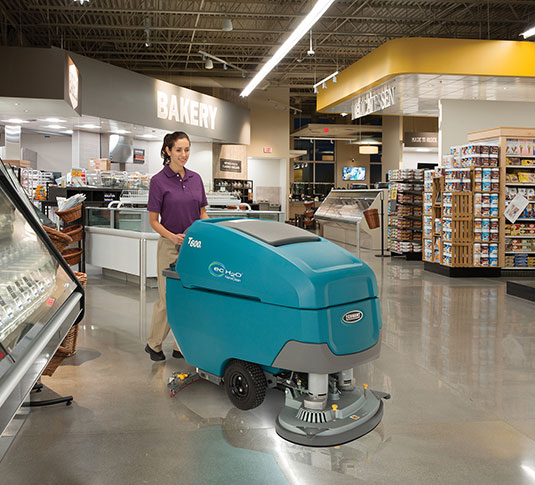Your shopping cart is empty.
What is Industrial Design and What Role Does it Play at Tennant?
Posted in Best Practices, Industry News & Trends,
Have you ever wondered how Tennant determines which floor cleaning machines to make, why your scrubber looks the way it does, or what the thought process was for certain innovations? While creating a new cleaning machine involves several teams across the organization, much of the process starts with our Industrial Design team.
Tennant Company’s Director of Industrial Design and Innovation, John Ickes, shares more about Industrial Design and how the team helps solve customer pain points, the process for designing new products, and provides a real example of how the team’s ethnography work gave them insights to create a simple but effective solution to a common cleaning crew experience.
What is Industrial Design (ID)?
Contrary to a common misconception, Industrial Designers don’t design factories. Rather, Industrial Design uses human empathy as the fuel to inspire a combination of creative thinking and artistic skill to solve user problems. Well-designed products and experiences make our customer’s jobs easier, more productive, and enjoyable.
How does the ID team help to solve customer pain points? Where does the ID team fit in the product development process?
The ID team most heavily contributes at the very beginning of the product development process. We first want to understand what’s important to our customers and strive to develop solutions that will make our product’s users more comfortable and productive in getting their work done. Additionally, it’s important to make the product evoke Tennant quality. We do that by striving to integrate product features into a cohesive, aesthetically pleasing design. Our products should look rugged, yet refined, and just like with people you meet, our products have but one chance to make a positive first impression.
What is the most important information the ID team needs before creating new products?
We need to understand the true user problems associated with the task for which we are developing a solution. We do this by interviewing our customer’s key decision makers, as well as end users who interact with our equipment. Often times, the best insights we gain are not from what people say, but through some of the struggles or opportunities we observe by just shadowing the cleaning crew. This “walk in the shoes” of the person doing the work is often very insightful and inspirational to new product ideas.
What is the process for designing a new product at Tennant Company?
The process begins with research. As I outlined above, it is important to get a solid understanding of our customer’s challenges and opportunities. Once the field research is done, the design team, along with cross-functional partners, evaluate the findings to look for commonalities, differences, and needs. From there, we can use tools like customer personas and journey maps to visualize various types of users, customers, and areas of focus. Next, the ID team will do a series of 1-2 week ideation sprints.
For each sprint, we select a key finding from the research and create as many solution sketches as possible. Throughout this process, we put all of our work up on project walls so we can continuously share and build off of each other’s ideas. We utilize a “step, stretch, and leap” mentality to our ideas to ensure we cover the problem thoroughly, don’t leave out simple solutions, and also don’t restrict our thinking to the easiest, or most near term.
At the conclusion of the ideation sprints, the concepts must go through the difficult process of down selection. Often, we have more than 100 ideas which must be narrowed down to a manageable number for customer testing.
Next, we create storyboards of the selected concepts and we go back to the same customers we originally interviewed and observed to show them our ideas. The customer’s preferences, aligned with our business goals, dictate which concepts will continue to a prototype build.
Once an idea is prototyped, more customer testing occurs. This time they are able to actually try the product and give us feedback about what they like and what they would improve. Once refined, the product concept is ready for a fully engineered production development.
Explain an example of identifying a customer problem and creating a solution that solved that problem.
One simple example would be the rear accessory rails that we developed for our walk-behind and stand-on machines. When observing cleaning in the field, many of our customers would tie trash bags to the control console of their floor scrubber for collecting large debris on their cleaning route. We saw this as an opportunity to provide our customer with hooks which snap on to rails at the rear of the machine to manage bags and additional tools such as spray bottles and wet floor signs. This simple solution keeps the control area uncluttered, enhances operation safety, and provides our customers with a machine feature to better accommodate an existing need.


John Ickes is the Director of Industrial Design and Innovation at Tennant Company. He holds a BFA from The College of Creative Studies in Detroit, MI and has extensive design and product development experience in several industries including design consulting, automotive, and floor cleaning equipment. He has multiple utility and design patents, and has received awards such as Good Design, and IDEA Awards.

